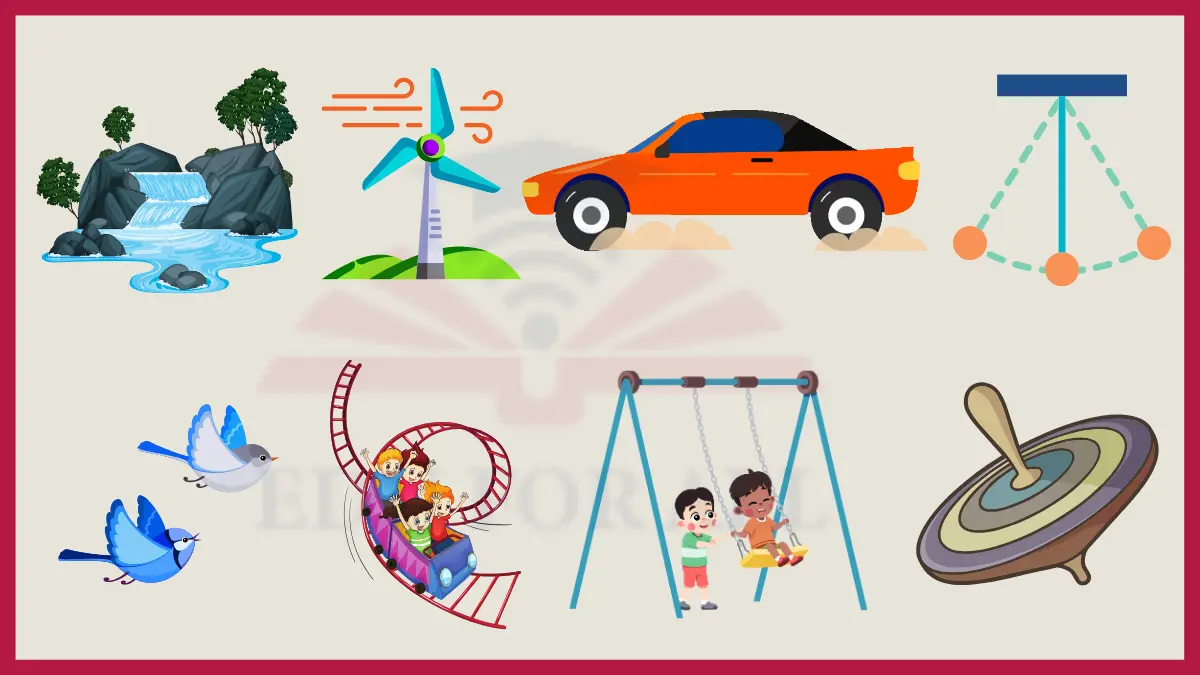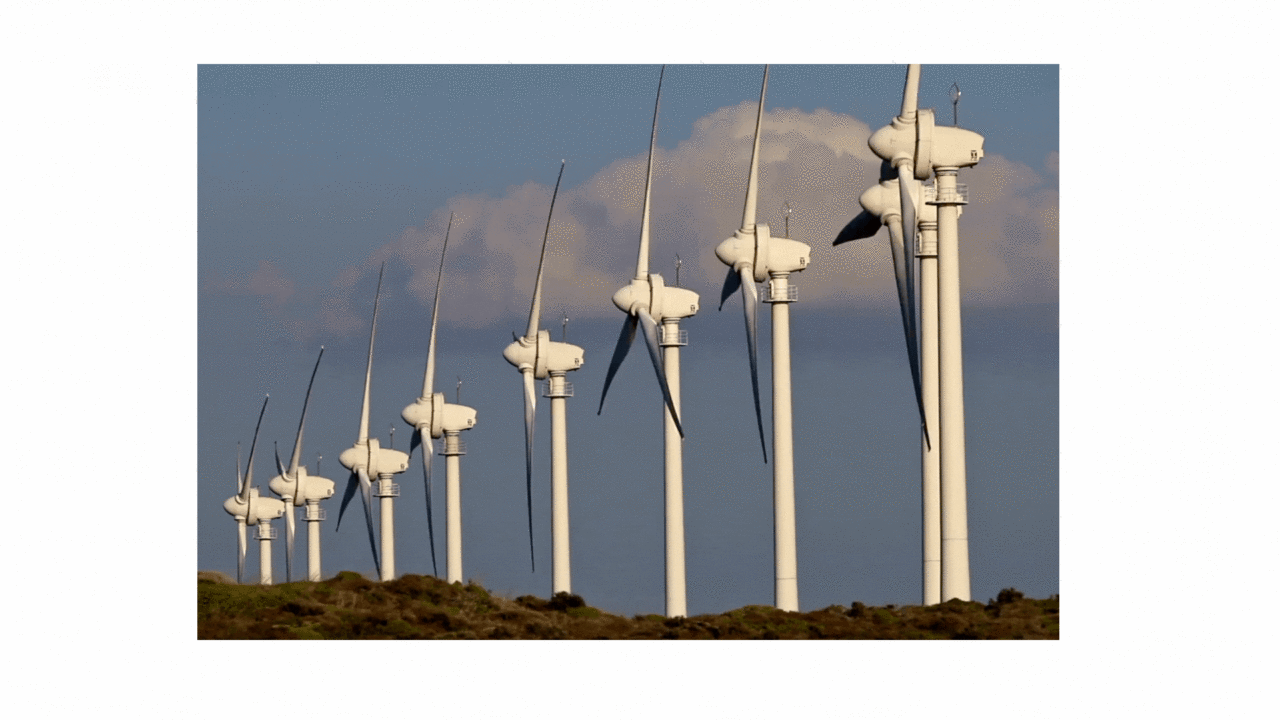The kinetic energy of a ball as it travels through the air, the kinetic energy of a flowing river, and the kinetic energy of the wind driving a wind turbine are all examples of Kinetic Energy.

- Examples of Kinetic Energy
- 1. Running Water
- 2. Wind Power
- 3. Moving Vehicles
- 4. Swinging Pendulum
- 5. Flying Birds
- 6. Jumping on Trampoline
- 7. Roller Coaster Ride
- 8. Dancing
- 9. Children on Swing
- 10. Spinning Top
- 11. Riding a Bike
- 12. Skating
- 13. Tennis Serve
- 14. Falling Leaves
- 15. Ping Pong Ball in Play
- 16. Speakers Playing Music
- 17. Flying Airplane
- 18. Bullet From a Gun
- 19. Dropping a Glass on Flood
Examples of Kinetic Energy
Here are 19 examples of kinetic energy:
1. Running Water
The flowing water in rivers and streams possesses kinetic energy as it moves downstream. The motion of the water represents kinetic energy, which is the energy possessed by an object due to its movement. As the water flows, it has energy associated with its velocity.

2. Wind Power
Wind, as it moves and causes the blades of a wind turbine to spin, is a manifestation of kinetic energy. The movement of air molecules in the wind contains kinetic energy. When the wind hits the blades of the turbine, it causes them to rotate, transferring its kinetic energy into the spinning motion of the turbine.

3. Moving Vehicles
Cars, bicycles, and any moving vehicle possess kinetic energy due to their motion. The faster a vehicle moves, the more kinetic energy it carries. This kinetic energy comes from the engine in the case of cars or the pedaling in bikes, which provides the force to propel the vehicle forward. The motion represents the kinetic energy being expended.
4. Swinging Pendulum
A swinging pendulum exhibits kinetic energy as it moves back and forth. As the pendulum swings, it transforms potential energy into kinetic energy. At the top of the swing, it has maximum potential energy, which is converted into kinetic energy as the pendulum gains speed moving downward. The kinetic energy is greatest at the bottom of the swing.
5. Flying Birds
Birds in flight have kinetic energy associated with their movement through the air. As the birds flap their wings to propel themselves forward, they generate kinetic energy. The faster they move their wings and the faster they fly, the greater their kinetic energy.
6. Jumping on Trampoline
When you jump on a trampoline, your body gains kinetic energy as it moves up and down. As you bounce, gravitational potential energy is converted into kinetic energy as you gain speed moving downward, then back into potential energy as you decelerate moving upward again. Your body exhibits kinetic energy due to its changing motion.
7. Roller Coaster Ride
The roller coaster cart gains kinetic energy as it descends from a height. At the top of a hill, it possesses maximum potential energy, which is converted into kinetic energy as gravity accelerates the cart downward. The high speeds and rapid motion of the roller coaster represent large amounts of kinetic energy.
8. Dancing
When you dance, your body is in motion, and therefore, it possesses kinetic energy. The faster your body moves as you dance, through steps, arm movements, jumps, and spins, the greater your kinetic energy. This kinetic energy comes from your muscles as they contract to produce the dance motions.
9. Children on Swing
Kids on a swing gain kinetic energy as the swing moves back and forth. As they swing back, potential energy increases, then this is converted into kinetic energy as they swing forward. At the bottom of the forward swing, kinetic energy is maximized as velocity is greatest. The repetitive pendulum motion keeps interchanging potential and kinetic energy.
10. Spinning Top
The spinning motion of a top represents kinetic energy. As the top is spun faster and faster, it gains kinetic energy associated with its rotational velocity. The kinetic energy is stored in the motion of the top as long as it continues spinning. Friction eventually dissipates the kinetic energy as the top slows down.
11. Riding a Bike
Whether pedaling uphill or cruising downhill, a bicyclist exhibits kinetic energy. Pedaling provides the force to propel the bike forward, causing it to gain speed and kinetic energy. Coasting downhill also increases kinetic energy as gravitational potential energy is converted into the motion of the bicycle.
12. Skating
Whether on ice or pavement, a person gliding on skates has kinetic energy. Pushing off provides the initial kinetic energy to start moving forward. This kinetic energy is maintained as long as the skater continues gliding in motion across the surface. Increased speeds lead to greater kinetic energy.
13. Tennis Serve
The motion of a tennis serve involves kinetic energy as the racket moves through the air. The player imparts force to the racket that is transferred into the kinetic energy of the moving racket and ball. The faster the ball is served, the greater its kinetic energy.
14. Falling Leaves
As leaves fall from trees, they have kinetic energy due to their downward motion. As gravity pulls them down, they accelerate and gain more kinetic energy. Air resistance dissipates some of this energy and slows their descent. The motion of the falling leaves represents their kinetic energy.
15. Ping Pong Ball in Play
A ping pong ball in motion, whether hit by a paddle or bouncing on the table, possesses kinetic energy. The ball gains kinetic energy when struck by the paddle. It maintains this kinetic energy through its flight and then when bouncing and moving across the table. The motion and speed of the ball reflect its kinetic energy.
16. Speakers Playing Music
The kinetic energy in speakers playing music comes from the amplifier’s power converting electrical signals into the back and forth motion of the speaker cones. This motion produces the sound waves.
17. Flying Airplane
The engines of an airplane generate force to propel it forward, giving it kinetic energy in flight. The motion of the plane through the air represents the kinetic energy that allows it to fly. The faster it moves, the more kinetic energy it has.
18. Bullet From a Gun
The explosive force propelling a bullet out of a gun barrel gives it kinetic energy. The speed and motion of the traveling bullet represent the large amounts of kinetic energy it carries.
19. Dropping a Glass on Flood
When released from a height, a glass has gravitational potential energy that is converted into kinetic energy as it falls and gains speed. The motion of the falling glass represents its kinetic energy until it hits the floor.

